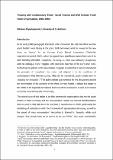‘Keeping with contemporary times’: social tourism and West German youth hostel organizations, 1950s-1980s
Abstract
This article examines the organizations that ran youth hostels in West Germany from the 1950s to 1989. It analyses whether they reconfigured their aims and practices against the backdrop of the cultural, social and political transformations that West Germany underwent throughout its existence, especially concerning the establishment of strong ties with ‘Western’ countries and the spread of mass consumption. It argues that while the maintenance of discipline among guests by youth hostel personnel remained important in the operation of West German youth hostels throughout the period in question, the norms around which discipline revolved and the ways in which it was enforced increasingly became negotiated between the officials of these associations and the guests at youth hostels. This process does not fall into the category of the ‘cultural revolution’ that occurred in the ‘Long Sixties’, according to Arthur Marwick, but amounted to a protracted and cautious experimentation that lasted several decades. While the historiography of tourism has hitherto analysed either the explosion of commercial tourism or the spread of anti-commercial travel from the 1960s onwards, shifting youth hostel policies help illuminate a popular type of tourism, which growingly developed synergies with both those travel patterns, but yet remained distinct from them.
Citation
Papadogiannis , N 2016 , ' ‘Keeping with contemporary times’: social tourism and West German youth hostel organizations, 1950s-1980s ' , Journal of Contemporary History , vol. 51 , no. 3 , pp. 660-687 . https://doi.org/10.1177/0022009415619688
Publication
Journal of Contemporary History
Status
Peer reviewed
ISSN
0022-0094Type
Journal article
Description
The research on which this article is based was generously financed by the Alexander von Humboldt Foundation.Collections
Items in the St Andrews Research Repository are protected by copyright, with all rights reserved, unless otherwise indicated.

